Saludos cordiales, comunidad de Foodies Bee Hive. En esta publicación les mostraré como hacer uno simples raviolis, se trata de una receta genérica, en nuestro caso los preparamos rellenos con un poco de guiso de carne de cerdo, que nos había sobrado de otra preparación, y los acompañamos una salsa simple de mantequilla y algunas hiervas, sin embargo lo importante es la preparación del ravioli, el relleno y la salsa puede ser el que más le guste.
Warm greetings, Foodies Bee Hive community. In this publication I will show you how to make a simple ravioli, this is a generic recipe, in our case we prepare them stuffed with a little pork stew, which we had left over from another preparation, and we accompany them with a simple butter sauce and some herbs, however the important thing is the preparation of the ravioli, the filling and the sauce can be the one you like the most.
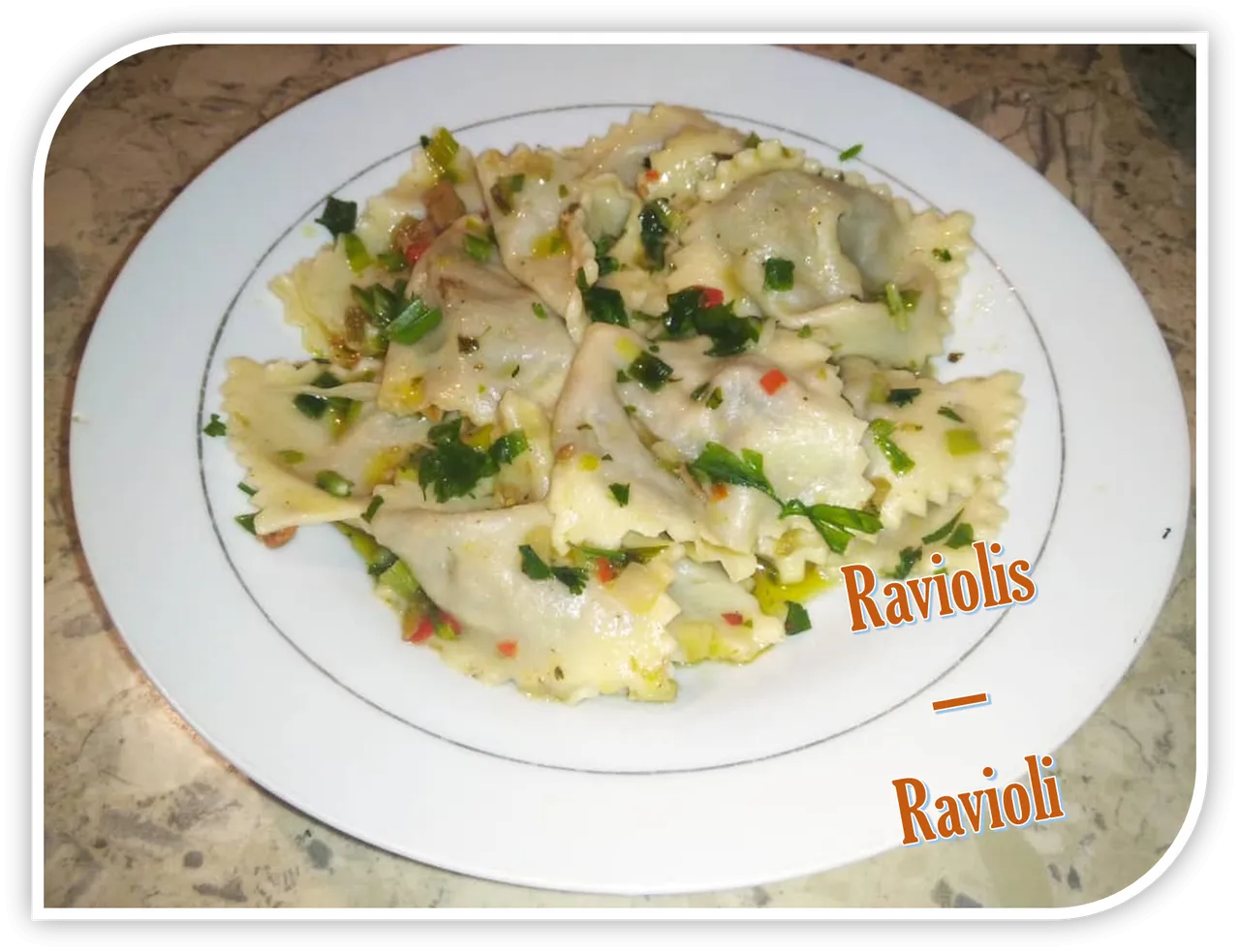

Ingredientes
Para cuatro comensales.
- 300 gr de harina de trigo todo uso
- 2 huevos
- 1 cucharada de aceite de oliva
- Sal suficiente para cocinar los ravioles
- Relleno para los raviolis
Para la salsa
- Mantequilla o margarina
- Un chorro de aceite de oliva
- Media taza de una mezcla de cebollín, perejil, ajís dulces, célere y puerros.
Ingredients
For four people.
- 300 gr all-purpose flour
- 2 eggs
- 1 tablespoon of olive oil
- Enough salt to cook the ravioli
- Filling for the ravioli
For the sauce
- Butter or margarine
- A dash of olive oil
- Half a cup of a mixture of chives, parsley, sweet peppers, celery and leeks.

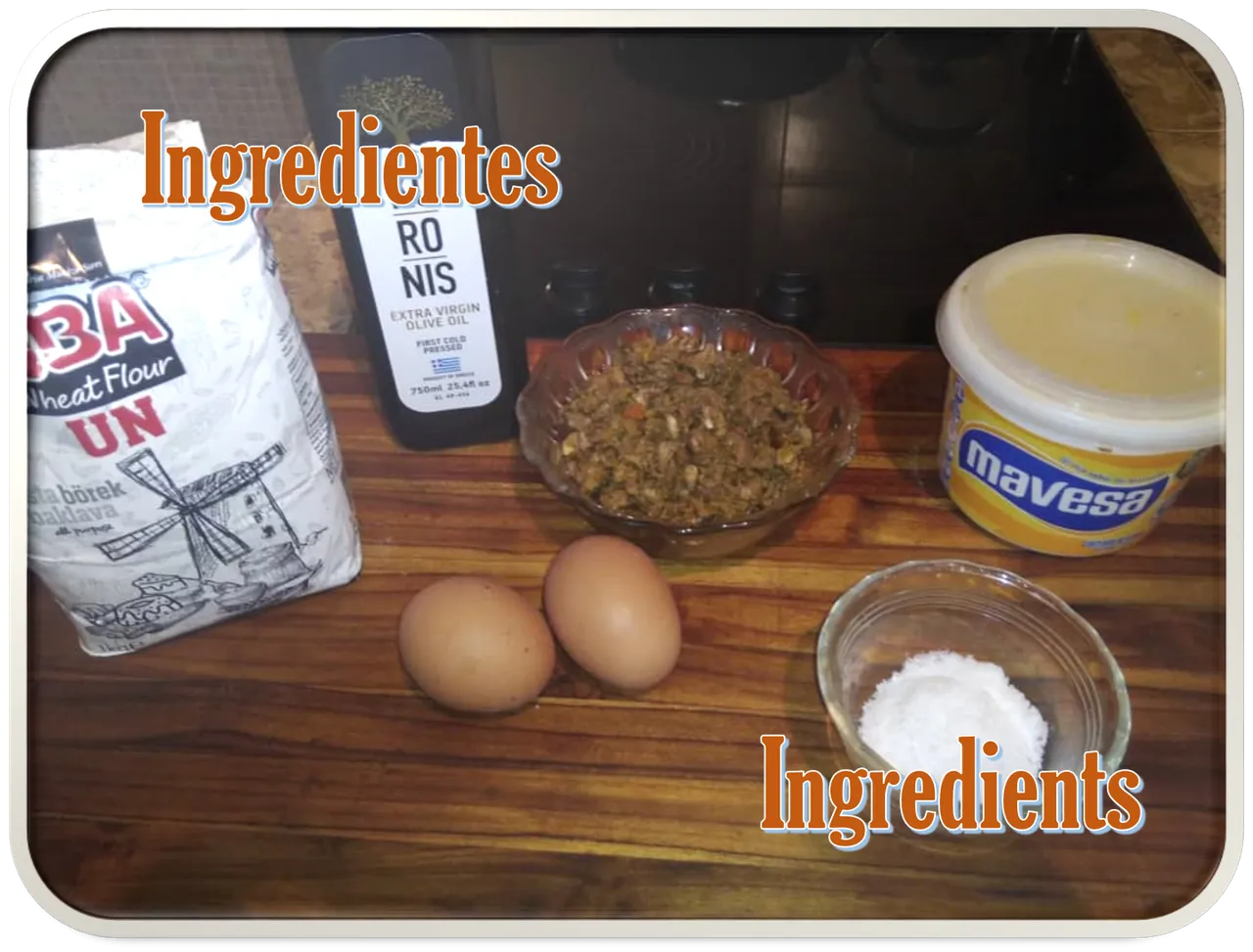

Procedimiento
Para empezar, colocaremos la harina en un bol (1), si nota la presencia de grumos, es conveniente cernirla primero, haremos un hueco en el medio de la harina y en él verteremos los huevos y 50 ml de agua a temperatura ambiente (2), si lo prefiere sustituya el agua por un huevo adicional, agregaremos el aceite de oliva y empezaremos a mezclar los huevos con un tenedor (3).
Continuaremos mezclando e integrando harina de los alrededores (4), hasta obtener una masa de consistencia suelta y harinosa pero que ya podremos manipular directamente con la mano (5), continuaremos incorporando la harina que quede suelta en el bol a la masa, hasta que se haya integrado toda y tengamos una bola de masa uniforme y compacta, no es necesario amasar demasiado, basta con haber integrado en su totalidad la harina, obtendremos una masa densa pero manejable (6), que dejaremos reposar en una bolsa plástica por treinta minutos.
Procedure
To begin, we will place the flour in a bowl (1), if you notice the presence of lumps, it is convenient to sift it first, we will make a hole in the middle of the flour and in it we will pour the eggs and 50 ml of water at room temperature (2), if you prefer replace the water with an additional egg, we will add the olive oil and begin to mix the eggs with a fork (3).
We will continue mixing and integrating flour from the surroundings (4), until we obtain a dough of loose and floury consistency but that we will be able to manipulate directly with the hand (5), we will continue incorporating the flour that remains loose in the bowl to the dough, until it is all integrated and we have a uniform and compact ball of dough, it is not necessary to knead too much, it is enough to have integrated in its totality the flour, we will obtain a dense but manageable dough (6), that we will let rest in a plastic bag for thirty minutes.

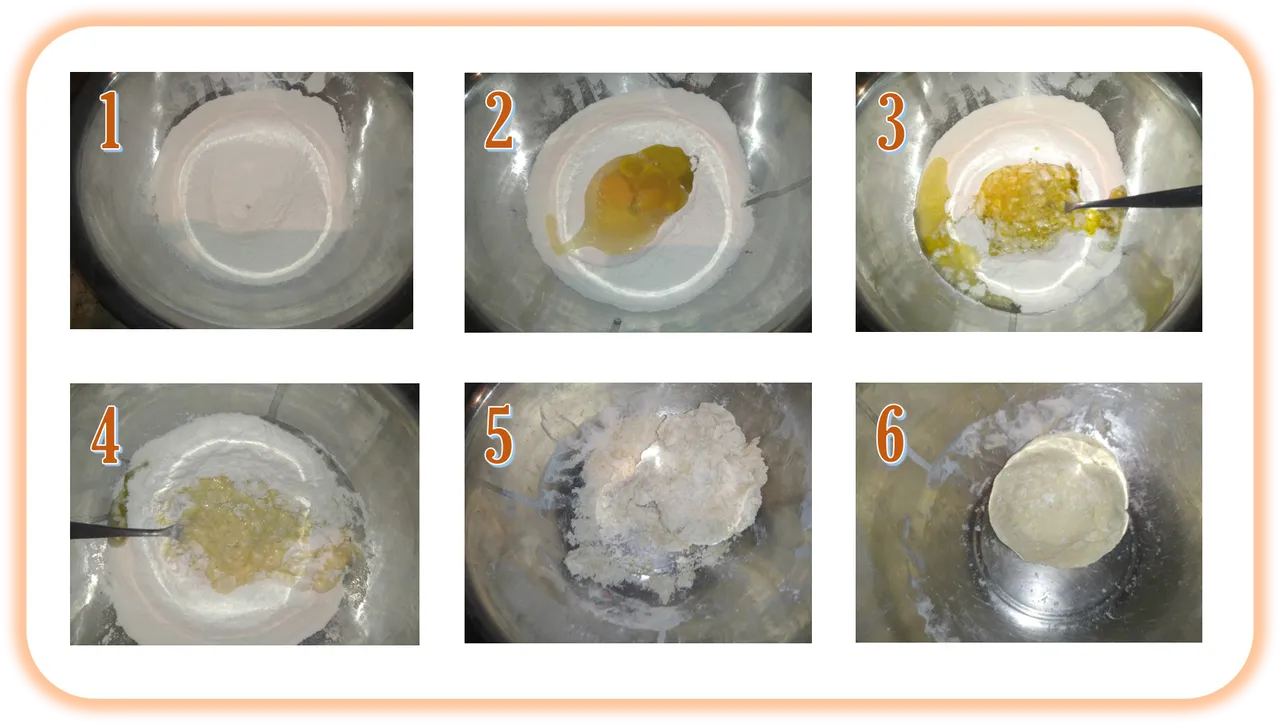

Pasado el tiempo, sacaremos la masa de la bolsa (7) y la dividiremos en tres o cuatro partes (8). El siguiente paso puede realizarse con una máquina laminadora (9), o con un rodillo, obviamente la primera opción es la más rápida y práctica, y fue la que yo seguí, pero no tener una de estas máquinas, no es impedimento para no preparar raviolis, pues podemos aplanar la masa usando un rodillo, preferiblemente pesado, para facilitar un poco el trabajo.
Lo primero será, usando un rodillo, aplanaremos un poco una de las porciones de masa, lo suficiente como para poder acomodarla por primera vez en la máquina (10), y la pasaremos usando la primera posición de la perilla de la máquina, que es la de mayor abertura y que estira con mayor grosor, la lámina de masa que obtendremos la espolvorearemos con harina, si la notamos un poco pegajosa, y la plegaremos sobre sí misma, en tres capas, como si dobláramos un sobre, y la volveremos a pasar por la máquina en la primera posición, esto lo debemos hacer al menos unas diez veces, de esta forma estaremos laminando la masa y activando su gluten para hacerla muy elástica.
Luego de este procedimiento, notaremos que nuestra masa se siente más lisa, uniforme y elástica, ahora empezaremos a estirarla, para ello moveremos la máquina a la posición 2 de la perilla y pasaremos nuestra lámina de masa, notaremos que su longitud se alarga y se hace más fina, cambiaremos a la posición 3 y repetiremos, y continuaremos así hasta obtener una tira larga de masa del grosor que nos parezca conveniente, mi máquina tiene 9 posiciones pero yo estiro la masa hasta la posición 7 u 8 para que no quede demasiado delgada y se pueda romper al manipularla (11).
Es conveniente espolvorear un poco de harina a lo largo de toda la tira de masa para evitar que se pegue si necesitamos plegarla o dejarla un momento sobre la mesada.
Para preparar los raviolis yo usé un molde para estos (12), se trata de una horma sobre la que se colocan las capas de masa y el relleno, existen también cortadores en forma de rodillo, o pueden hacerse simplemente extendiendo la masa, posicionando bolitas de relleno y luego cubriendo con otra capa de masa y presionando con los dedos por los bordes para sacar el aire y unir las dos capas de masa y cortándolos luego con un cuchillo o un cortador.
After the time has elapsed, we will take the dough out of the bag (7) and divide it into three or four parts (8). The next step can be done with a rolling machine (9), or with a rolling pin, obviously the first option is the fastest and most practical, and was the one I followed, but not having one of these machines, is not an impediment to not prepare ravioli, because we can flatten the dough using a rolling pin, preferably heavy, to facilitate the work a little.
The first thing will be, using a rolling pin, we will flatten a little one of the portions of dough, enough to be able to accommodate it for the first time in the machine (10), and we will pass it using the first position of the knob of the machine, which is the one with the largest opening and that stretches with greater thickness, the sheet of dough that we will obtain we will sprinkle it with flour, if we notice it a little sticky, and we will fold it on itself, in three layers, as if we were folding an envelope, and we will pass it again through the machine in the first position, we must do this at least ten times, in this way we will be laminating the dough and activating its gluten to make it very elastic.
After this procedure, we will notice that our dough feels smoother, uniform and elastic, now we will begin to stretch it, for this we will move the machine to position 2 of the knob and we will pass our sheet of dough, we will notice that its length becomes longer and thinner, we will change to position 3 and repeat, and we will continue this way until we get a long strip of dough of the thickness that we find convenient, my machine has 9 positions but I stretch the dough to position 7 or 8 so that it is not too thin and can break when handling it (11).
It is convenient to sprinkle a little flour along the entire strip of dough to prevent it from sticking if we need to fold it or leave it for a moment on the counter.
To prepare the ravioli I used a mold for these (12), it is a die on which the layers of dough and the filling are placed, there are also cutters in the shape of a rolling pin, or they can be made simply by extending the dough, placing balls of filling and then covering with another layer of dough and pressing with the fingers along the edges to remove the air and join the two layers of dough and then cutting them with a knife or a cutter.

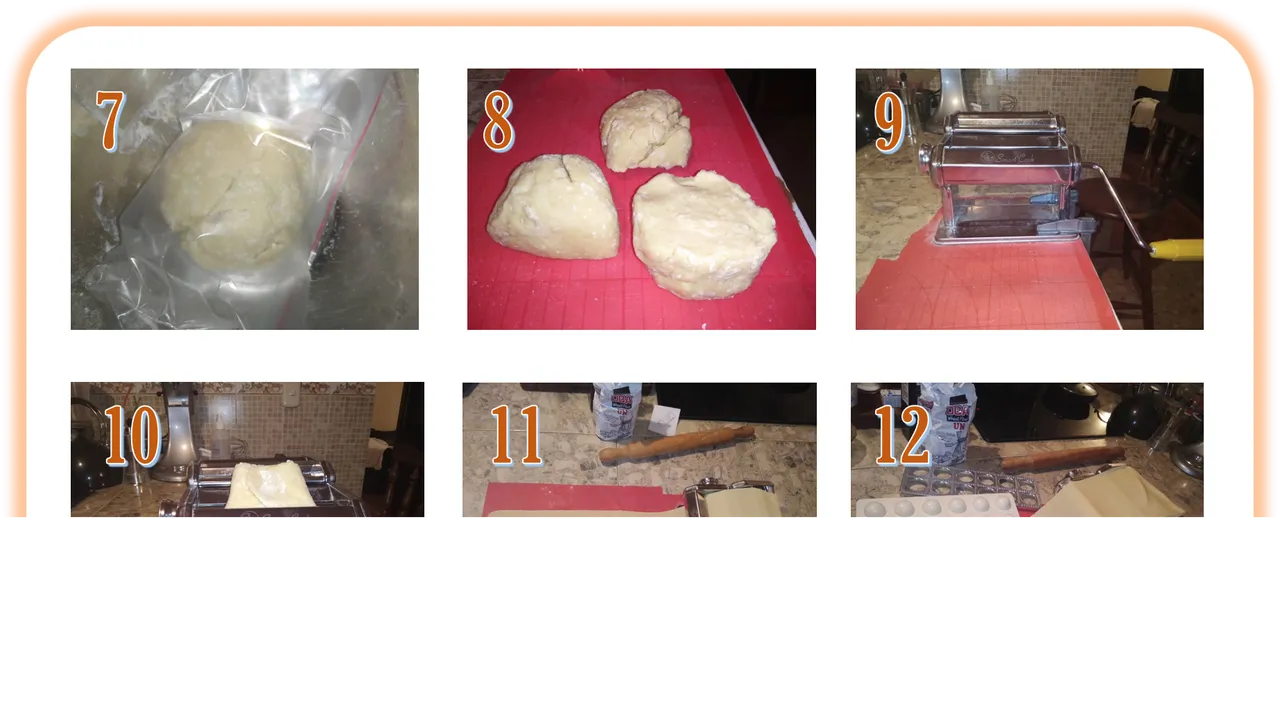

En el caso de tener un molde como el que tengo yo, solo debemos extender la capa de masa sobre él (13), presionarla con la tapa, para hacer las hendiduras para el relleno (14) (15) y colocar una bolita o cucharadita de relleno en cada hendidura (16), para luego cubrirlos con otra capa de masa (17) y pasarle un rodillo, haciendo presión sobre los bordes externos e internos para que corten la masa (18).
If you have a mold like the one I have, just spread the layer of dough on it (13), press it with the lid to make the indentations for the filling (14) (15) and place a small ball or teaspoon of filling in each indentation (16), then cover them with another layer of dough (17) and roll it with a rolling pin, pressing on the outer and inner edges to cut the dough (18).

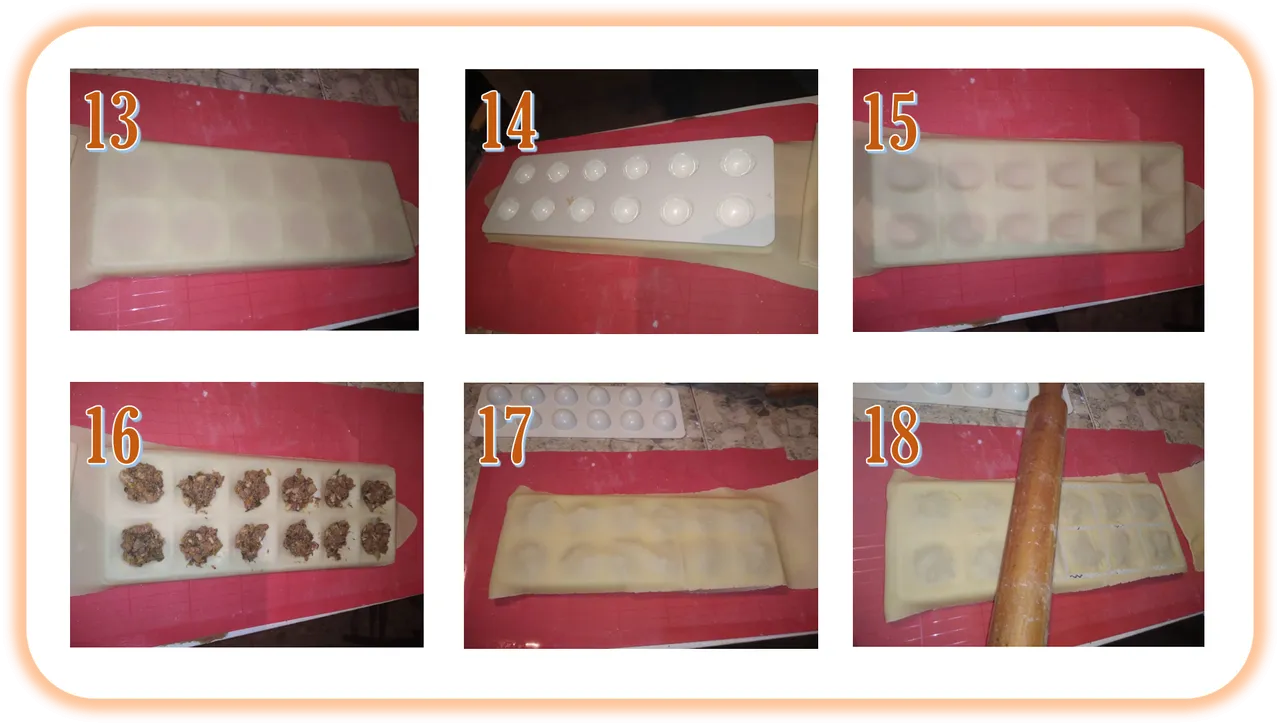

Retiraremos el sobrante de los bordes (19) y daremos la vuelta a la horma para dejar que caigan los raviolis, si algunos se quedan pegados a la horma, los empujaremos suavemente con los dedos (20), luego los colocaremos sobre una bandeja espolvoreada con harina, para que no se peguen (21), este mismo procedimiento deberemos repetirlo con cada porción de masa de las que habíamos cortado en el paso (8).
Cuando hayamos hecho todos los raviolis, los llevaremos a cocinar en una olla con abundante agua hirviendo a la que colocaremos suficiente sal (22), los dejaremos caer al agua y una vez que rompa nuevamente el hervor, los retiraremos cuando empiecen a flotar (23), reservando un poco del agua para la preparación de la salsa.
We will remove the excess of the edges (19) and we will turn the baking pan to let the ravioli fall, if some remain stuck to the baking pan, we will push them gently with the fingers (20), then we will place them on a tray sprinkled with flour, so that they do not stick (21), this same procedure we will have to repeat it with each portion of dough of those that we had cut in step (8).
When we have made all the ravioli, we will take them to cook in a pot with abundant boiling water to which we will put enough salt (22), we will let them fall to the water and once it breaks the boil again, we will remove them when they begin to float (23), reserving a little of the water for the preparation of the sauce.

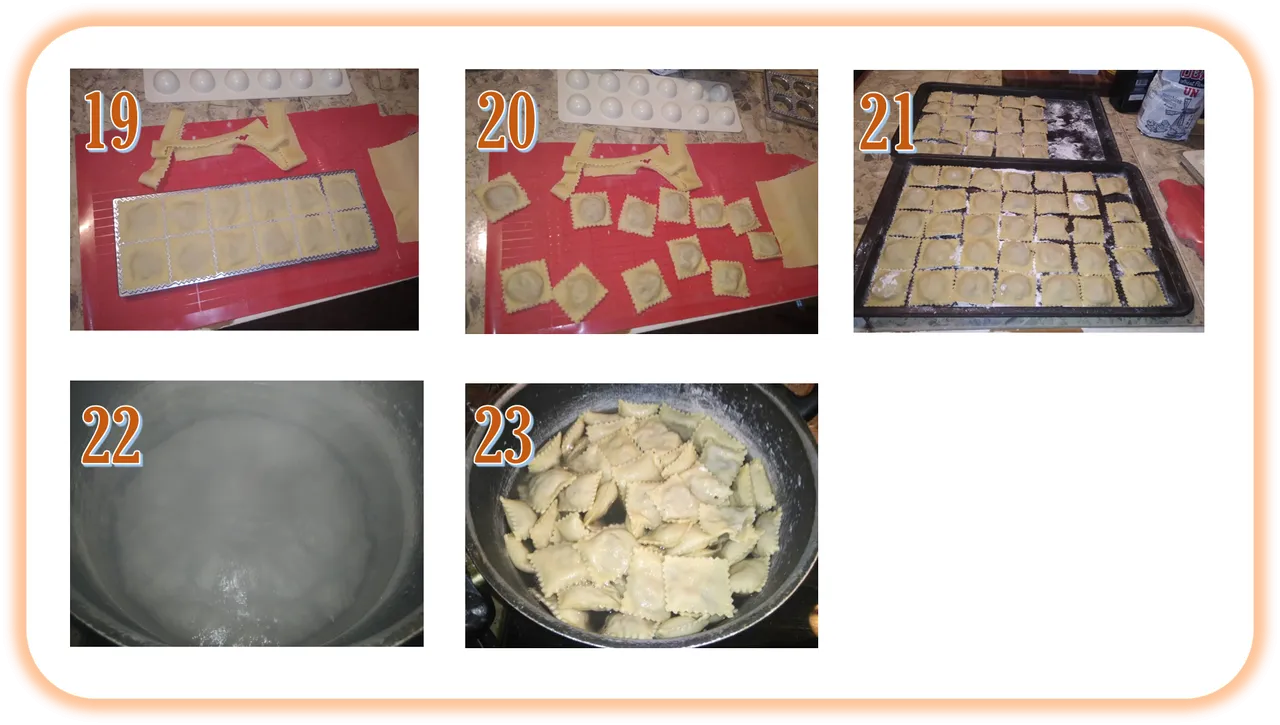

Para la salsa pondremos a calentar aceite de oliva (24), cuando se esté caliente agregaremos una cantidad generosa de mantequilla y dejaremos que se derrita (25), pondremos las hiervas y dejaremos infusionar por unos tres a cinco minutos, o hasta que se vean ligeramente amortecidas (26), agregaremos los raviolis y una media taza del agua de cocción, los mezclaremos con cuidado de que no se rompan y dejaremos que el líquido reduzca un poco (27), luego de esto, los serviremos.
For the sauce, heat the olive oil (24), when it is hot add a generous amount of butter and let it melt (25), add the herbs and let them infuse for three to five minutes, or until they are slightly browned (26), add the ravioli and a half cup of the cooking water, mix them carefully so that they do not break and let the liquid reduce a little (27), then serve them.

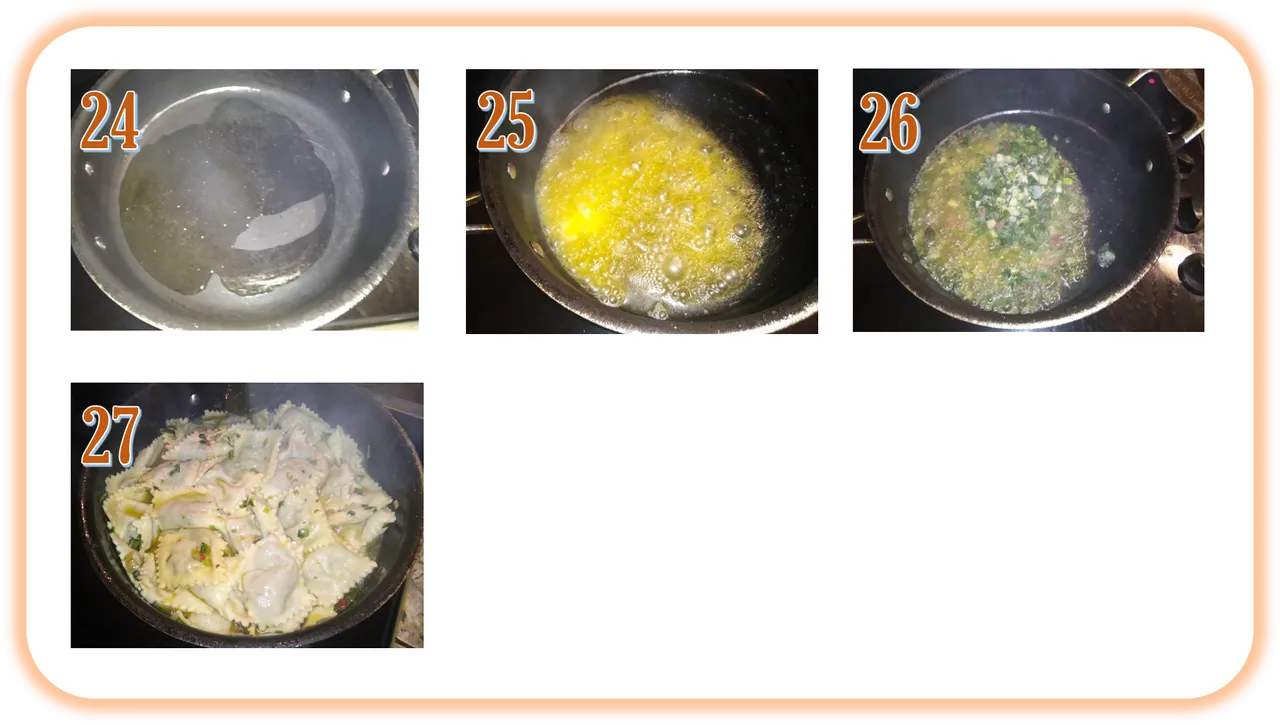

Si bien son una preparación un poco compleja, es muy satisfactorio comer raviolis preparados en casa, aparte de que resultan más ricos que los que pueda comprar en el supermercado, como dije antes el relleno y la salsa queda a su elección, yo los he preparado con una mezcla de ricota y albahaca o ricota y chorizo italiano, también pueden llevar jamón o una mezcla de vegetales, como salsa pueden acompañarse con salsa de crema o de tomate, la variedad de combinaciones es ilimitada, incluso si sustituye los huevos de la preparación de la masa, por agua, puede hacer unos ricos raviolis veganos.
Although they are a little complex to prepare, it is very satisfying to eat ravioli prepared at home, apart from the fact that they are richer than the ones you can buy in the supermarket, as I said before the filling and the sauce is up to your choice, I have prepared them with a mixture of ricotta and basil or ricotta and Italian sausage, They can also have ham or a mixture of vegetables, as a sauce can be accompanied with cream sauce or tomato sauce, the variety of combinations is unlimited, even if you replace the eggs in the preparation of the dough, for water, you can make a rich vegan ravioli.

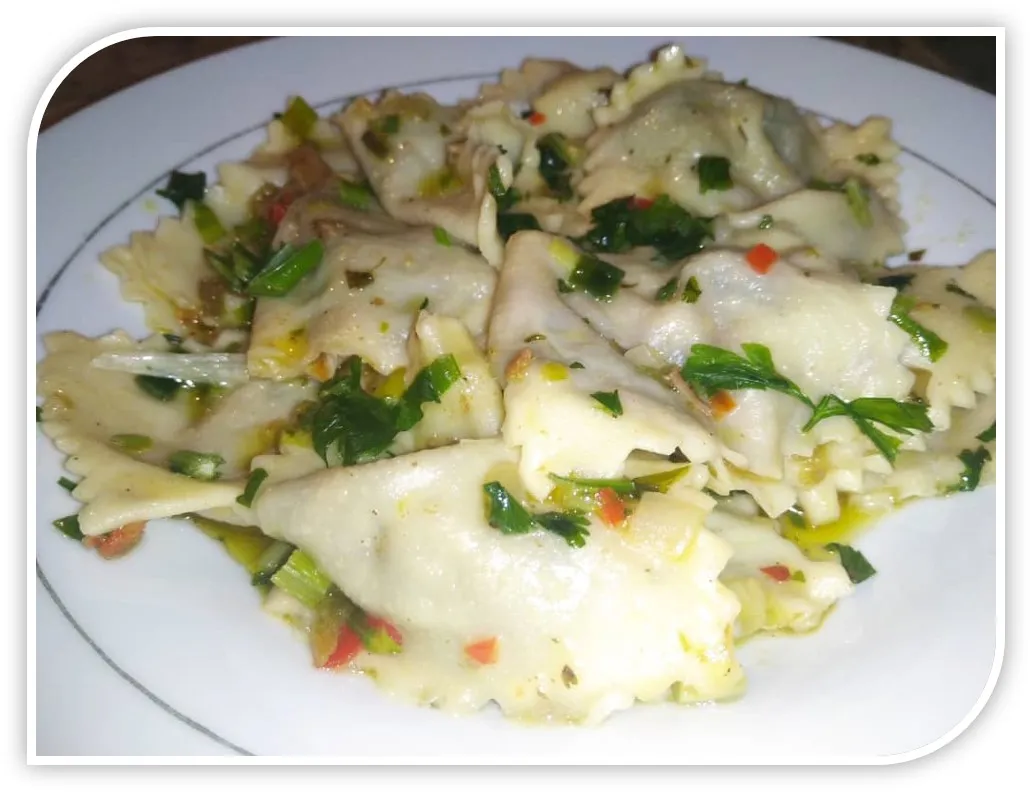

Todas las fotografías fueron tomadas con un movil Redmi 8A